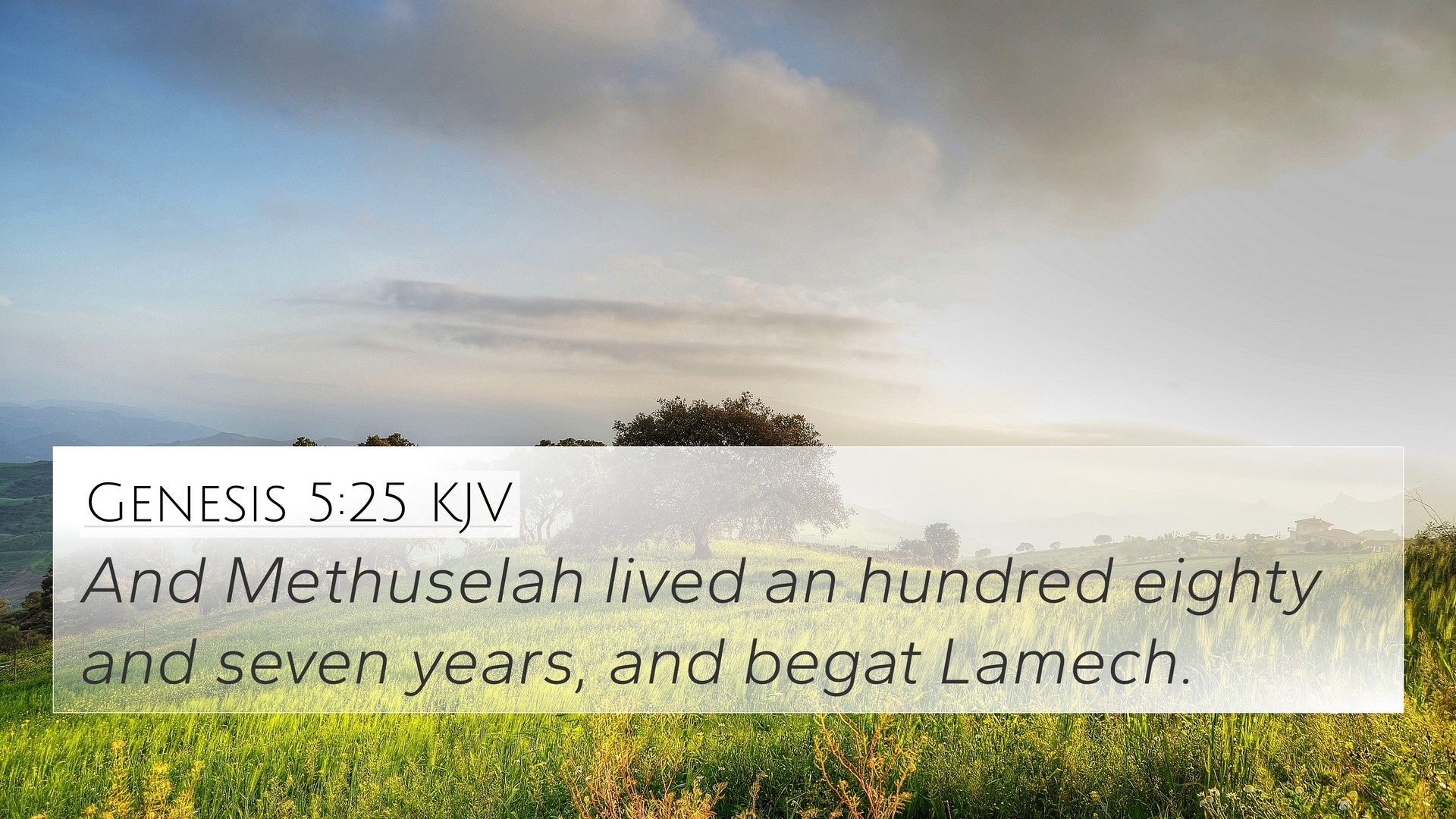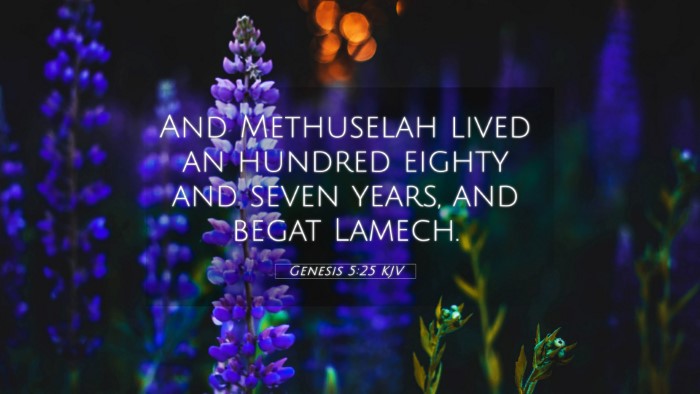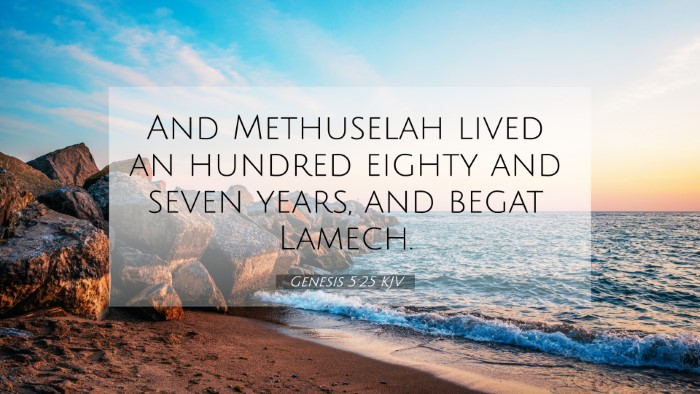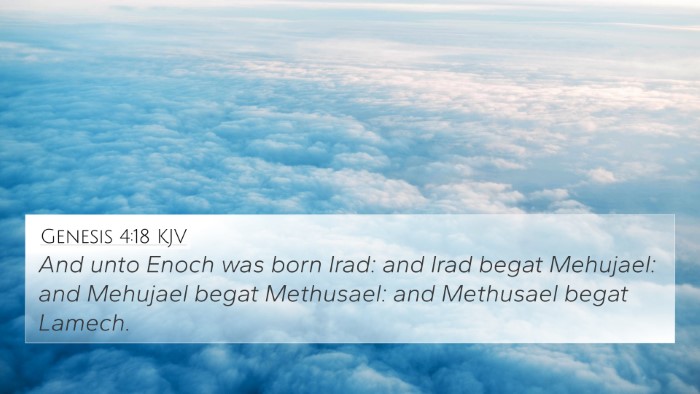Understanding Genesis 5:25
Genesis 5:25 states: "And Methuselah lived a hundred eighty and seven years, and begat Lamech." This verse introduces Methuselah, the oldest figure in the Bible, and his son Lamech, who is significant in the genealogy leading to Noah. Here, we will explore the meaning and context of this verse through insights gathered from several public domain commentaries.
Contextual Background
This passage is situated in the genealogical record that spans from Adam to Noah. Methuselah, as the grandfather of Noah, plays a crucial role in the lineage that ultimately links all mankind through the covenant with Noah after the Flood.
Commentary Insights
-
Matthew Henry:
Henry notes the remarkable longevity of Methuselah, highlighting that his life serves as a reminder of God's grace and patience with humanity. With each name in this genealogy, there is a sense of continuity and divine purpose. Methuselah’s long life is both a blessing and a warning, suggesting that while God offers life, His time for judgment is inevitable.
-
Albert Barnes:
Barnes emphasizes the significance of Methuselah's age, which symbolizes the grace period for mankind. His life represents the final opportunities given before the judgment of the Flood. The birth of Lamech signifies a transition in human history and prepares for the coming of Noah, who would become a pivotal figure in Biblical history.
-
Adam Clarke:
Clarke notes the importance of Methuselah's family line. Lamech's birth represents hope and anticipation in an increasingly sinful world. The name Lamech (meaning "despair") contrasts with the hope for salvation that Noah will later embody. Clarke interprets Methuselah’s name ("his death shall bring") as a prophetic warning of the impending judgment.
Bible Verse Cross-References
Genesis 5:25 has several related verses that deepen our understanding of the themes present in its narrative. Here are key cross-references:
- Genesis 5:22-24: Discusses the walk of Enoch with God, leading to Methuselah’s birth.
- Genesis 6:5-8: The context of human wickedness that leads to the Flood.
- Genesis 9:29: Citing Noah’s lineage and his significance after the Flood.
- Hebrews 11:5: References Enoch’s translation and prophetic insights into the future state.
- Matthew 1:1-16: The genealogy of Christ showing the importance of lineage.
- Luke 3:37: Lists Methuselah in the genealogy leading to Christ.
- Romans 5:12: Discusses sin entering the world through Adam, connecting back to these genealogies.
- 1 Peter 3:20: Mentions Noah and the antediluvian world, linking to Methuselah and Lamech’s significance.
- 2 Peter 3:9: God’s patience in the face of sin, echoing Methuselah’s long life.
Thematic Connections
In studying Genesis 5:25, several thematic connections can be drawn:
-
The Longevity of Life:
The long lifespans recorded in Genesis symbolize God’s mercy and the close relationship humanity had with Him before the Flood.
-
Genealogy and Salvation History:
This verse highlights the importance of genealogical records in understanding the unfolding of God's plan for redemption through Noah and ultimately Jesus Christ.
-
The Prophetic Elements:
The meanings of names in the genealogy often reflect God’s message to humanity, with Methuselah’s name reminding us of impending judgment.
-
Divine Patience:
Methuselah’s long life serves as a testament to God’s patience, extending grace before the judgment of the Flood.
Tools for Bible Cross-Referencing
Understanding Genesis 5:25 can be enriched utilizing various tools and methods for Bible cross-referencing:
- Bible Concordance: A helpful resource for finding specific verses and their contexts.
- Bible Cross-Reference Guide: Guides that show relationships between verses to explore interconnected themes.
- Cross-Reference Bible Study: Methods for studying the Bible by exploring thematic connections through various scripture references.
- Bible Chain References: A method of linking verses thematically throughout the text.
- Comprehensive Bible Cross-Reference Materials: Resources that provide extensive lists and descriptions of related verses.
Conclusion
Genesis 5:25 is not merely a genealogical record but a rich tapestry of themes reflecting God’s grace, patience, and the unfolding narrative of salvation history. By studying this verse through the lens of public domain commentaries and cross-referencing with other Biblical texts, readers can gain profound insights into the nature of God and His covenant with humanity.



